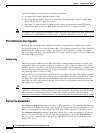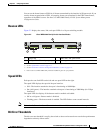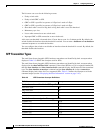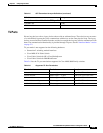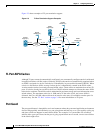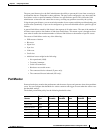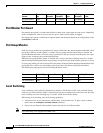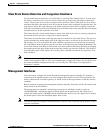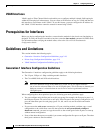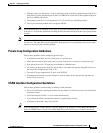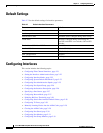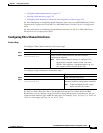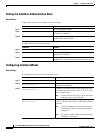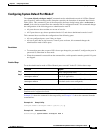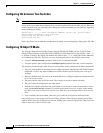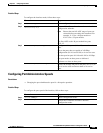
2-18
Cisco MDS 9000 Family NX-OS Interfaces Configuration Guide
OL-29284-01, Release 6.x
Chapter 2 Configuring Interfaces
Prerequisites for Interfaces
VSAN Interfaces
VSANs apply to Fibre Channel fabrics and enable you to configure multiple isolated SAN topologies
within the same physical infrastructure. You can create an IP interface on top of a VSAN and then use
this interface to send frames to this VSAN. To use this feature, you must configure the IP address for
this VSAN. VSAN interfaces cannot be created for nonexisting VSANs.
Prerequisites for Interfaces
Before you begin configuring the interfaces, ensure that the modules in the chassis are functioning as
designed. To verify the status of a module at any time, enter the show module command in EXEC mode.
For information about verifying the module status, refer to the Cisco NX-OS Fundamentals
Configuration Guide.
Guidelines and Limitations
This section includes the following topics:
• Generation 1 Interface Configuration Guidelines, page 2-18
• Private Loop Configuration Guidelines, page 2-19
• VSAN Interface Configuration Guidelines, page 2-19
Generation 1 Interface Configuration Guidelines
The Generation 1 interfaces configuration guidelines apply to the following hardware:
• The 32-port, 2-Gbps or 1-Gbps switching module interfaces
• The Cisco MDS 9140 and 9120 switch interfaces
Note Due to the hardware design of the MDS 9134 switch, we do not support interface
out-of-service action on either of its two 10-Gigabit ports. This is because no internal port
hardware resource is released when an out-of-service action is performed on these
10-Gigabit ports.
When configuring these host-optimized ports, the following port mode guidelines apply:
• You can configure only the first port in each 4-port group (for example, the first port in ports 1-4,
the fifth port in ports 5-8, and so on) as an E port. If the first port in the group is configured as an E
port, the other three ports in each group (ports 2-4, 6-8, and so on) are not usable and remain
shutdown.
• If you execute the write erase command on a 32-port switching module, and then copy a saved
configuration to the switch from a text file that contains the no system default switchport
shutdown command, you need to copy the text file to the switch again for the E ports to come up
without manual configuration.
• If any of the other three ports are enabled, you cannot configure the first port as an E port. The other
three ports continue to remain enabled.



